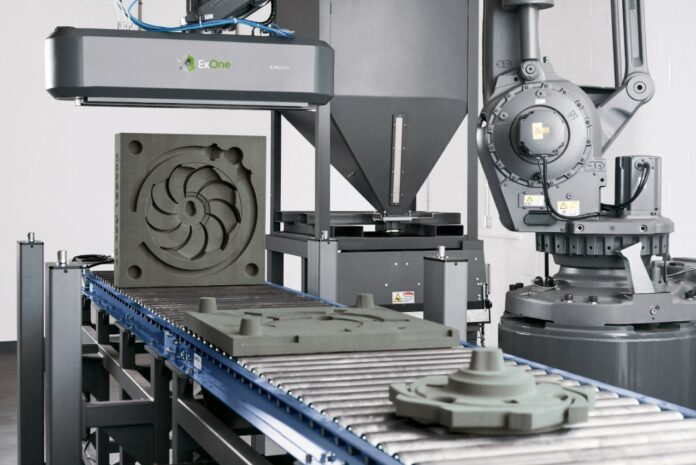Robotic 3D printing is trending and for good reason, robotic solutions have opened new avenues of automation in numerous manufacturing industries. Manufacturers and industrials who have understood this potential are currently exploring an exciting paradigm where they could harness the benefits of additive manufacturing in a diverse range of applications.
AM company Desktop Metal will now enable companies to reach a new level of automation in manufacturing by launching a new robotic sand 3D printing machine. Named ExOne S-Max® Flex, the large-format binder jetting system has been designed for foundries which want to quickly cast complex metal designs for various industries in mind. It joins the premium S-Max® and S-Max® Pro solutions that are used in foundries across the world.
This release follows the launch of the company’s new line of binder jet 3D printing systems.
It also gives another reason why the acquisition of ExOne by Desktop Metal is a powerhouse marriage for binder jetting. Indeed, the new machine combines ExOne’s sand printing expertise in process and materials with proprietary Desktop Metal SPJ technology. The combination of these capabilities also enables to deliver an affordable product for foundries that have often found sand 3D printing out of reach.
“To achieve our vision of Additive Manufacturing 2.0, we need to make production 3D printing practical in terms of speed, cost, and material availability for a broad range of applications,” said Ric Fulop, Co-Founder and CEO of Desktop Metal. “We designed the all-new S-Max Flex from the ground up leveraging SPJ technology with the idea of making premium sand 3D printing accessible to every foundry, so that more companies can take advantage of the benefits of AM 2.0, such as distributed, local production, and remain competitive for the long term.”
From a technical standpoint, it should be noted that the proprietary SPJ technology delivers a build rate up to 115 l/h. The integrated industrial robot works with an all-new end effector printhead design that deposits binder into a 1900 x 1000 x 1000 mm (74 x 39 x 39 in) telescoping build box that grows as the parts are built layer by layer. Additional build box sizes are available up to 4700 x 1000 x 1000 mm (185 x 39 x 39 in), with taller versions available up to 1000 x 2500 x 2400 mm (39 x 98 x 94 in).
The all-new S-Max Flex prints standard silica sand with furan binders and delivers final parts with dimensional accuracy of +/- 0.5 mm. The system comes with several accessories and safety features that are configurable to fit a variety of spaces, a press communication reads.
While the focus is made on foundries, the manufacturer reminds that industries beyond metalcasting are also set to take advantage of the S-Max Flex’s large form factor and ability to binder jet a variety of powders.
Infiltrated sand tooling for plastic thermoforming, composite layup, and sacrificial tooling applications are printed today on S-Max machines, along with infiltrated sand consumer products, such as those offered by Sandhelden and Deeptime. Desktop Metal’s Forust brand, which upcycles byproducts of the wood waste stream into consumer designs, will also leverage the new system to print large form factor wood parts at scale cost-effectively. Additional projects are underway printing reclaimed concrete and other materials, Desktop Metal announces.
Read more about Desktop Metal in an exclusive interview: How & Why Does Desktop Metal Build a Portfolio of “AM 2.0” Print Platforms?
Remember, you can post job opportunities in the AM Industry on 3D ADEPT Media free of charge or look for a job via our job board. Make sure to follow us on our social networks and subscribe to our weekly newsletter : Facebook, Twitter, LinkedIn & Instagram ! If you want to be featured in the next issue of our digital magazine or if you hear a story that needs to be heard, make sure to send it to contact@3dadept.com






